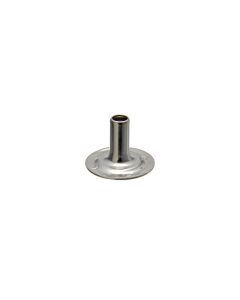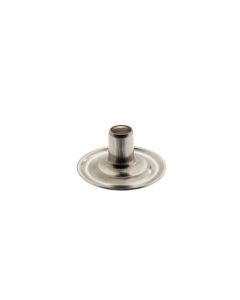Probes - emcee5601/fit-testing-resources GitHub Wiki
4mm OD post to fit into the sampling tubes. Should be tapered.
These come in 2 pieces. You need the probe part and the push nut part. Sometimes these are sold together, sometimes separately. Depends on source.
 |
Probe part looks like this | |
 |
Push nut (star lock washer) looks like this |
These seem reasonably standard with 4mm OD posts.
| image | notes | examples |
|---|---|---|
 |
5/16" (7.9mm) posts are usually good enough. Sometimes will be too short and can unexpectedly detach from the tube during movement. Be sure to insert fully into the tube. These are sometimes referred to as "long post". | https://www.sailrite.com/Snap-Pull-The-Dot-Eyelet-5-16-Nickel-Plated-Key-D |
 |
3/8" (9.5mm) posts are about the same length as the Nukit probes. These are generally 2x the price of 5/16" ones, but should be long enough in most situations. At this length, unexpectedly detaching from the tube shouldn't be a concern if fully inserted into the tube. These are sometimes referred to as "extra long post". | https://www.dotfasteners.com/catalogsearch/result/?q=eyelets+3%2F8 |
 |
1/4" (6.35mm) posts seems to be the most common size. These are too short. | https://www.dotfasteners.com/catalogsearch/result/?q=eyelets+1%2F4 |
Pros:
- Commodity items
- Cheaper than commercial probes
Cons:
- 3/8" (9.53mm) seems to be the longest posts easily available. (about 2x the cost of 5/16")
- 5/16" (7.937mm) can detach from the probe when tugged on repeatedly during some testing exercises
Examples:
- 3/8" (9.53mm) https://www.dotfasteners.com/catalogsearch/result/?q=eyelets+3%2F8
- 5/16" (7.9375mm) https://www.sailrite.com/Snap-Pull-The-Dot-Eyelet-5-16-Nickel-Plated-Key-D
 |
Alibaba has some vendors that sell these | example |
Pros:
- Cheap
- might come with push nuts (double check with the vendor)
Cons:
- Minimum order is 50,000 units or more
- Flange doesn't appear to be tapered. Not sure if it would make a difference.
Examples:
- Aluminum, min order 50,000 units: https://www.alibaba.com/product-detail/Good-Quality-Aluminum-Hollow-Rivet-for_1601193259026.html
- min order 1,000,000 units: https://www.alibaba.com/product-detail/probes_1601216196274.html
These are paired with the eyelets above.
| example | ||
|---|---|---|
 |
3.5mm ID. These go with the eyelets above. | https://www.amazon.com/dp/B0CX5DX993 |
 |
made for 4mm studs. these might a better fit | https://www.clipsandfasteners.com/4mm-Stud-Push-On-Retainer-11mm-O-D-Phosphate-p/a12119.htm |
Examples:
- 3.5mm ID: https://www.amazon.com/dp/B0CX5DX993
- These are a little on the tight side
- Better might be 5/32" ID which is 3.96875mm
These seem to be 11.6mm tall (bottom of flange to tip), so probably 11mm LUF (Length Under Flange). Outer diameter of the post is 4mm. Flange is about 14.2mm. Stainless steel.
Pros:
- Purpose built
- Comes with push nuts
Cons:
- Expensive
Examples:
- https://www.google.com/search?q=mask+fit+test+probes
- A company called 柴田科学(Shibata Kagaku) in Japan also makes these. They're called "tube joint sets type m" (6800 yen (~$43) for 100): https://www.axel-gl.com/en/asone/d/2-4311-32/
(not recommended) While these can work, installation options are more limited vs the wider flange options. Installation success is also less consistent because sometimes the rivet can go through the hole punched into the filter material because the flange is so narrow.
 |
4mm x 10mm hollow rivets. The flange on these are narrow. There's a chance these will go through the hole in the mask. | example |
Pros:
- Commodity items
- Cheap
Cons:
- Flange is pretty narrow. Maybe not enough overlap between flange and filter material.
- Installation can be finicky and rivet may go completely through the hole.
- Using a centerpunch to install risks cutting the filter material.
- Matching washers are thin, reducing installer options. (Ceiling grid punch pliers don't work.)
Examples:
- 4mm x 8mm Through Hole Copper Hollow Rivets: https://www.amazon.com/dp/B07RHNNB2P
- 4mm x 10mm: https://www.amazon.com/dp/B07RKWVNDM
These can be paired with the hollow rivets above. Make sure to get the ones with ID 3 or 3.5mm so they can grab onto the rivet. 4mm ID ones won't grab onto them at all.
 |
M3. These go with the hollow rivets above. | example |
Pros:
- cheap
- commodity item
Cons:
- These are pretty thin, so there are fewer installer options.
- Not much margin for error on installation an fit.
Examples:
- M3 Internal Tooth Star Lock Washers: https://www.amazon.com/dp/B0CG39FWNQ
Donning masks and adjusting fit takes a lot of time. Attaching the sampling tube to the mask while it's on the face is hard and can mess up the mask fit. We can try to avoid these problems by having a mechanism that allows for quickly attaching the tube without disturbing the mask fit.
We can attach a short segment of tubing (say 2 inches, see sampling tube options) to the probe on the mask and join it to the sampling tube using a slightly larger tube (of length 1.25 inches). This lets us make the attachment without disturbing the mask. The participant can adjust and wear the mask as normal while waiting their turn. The short segment of tube must be plugged while the participant waits.
| image | description | examples |
|---|---|---|
 |
Silicone Tubing, 1/4"(6mm) ID x 5/16"(8mm) OD
Use this to join the tubes. Mask > Probe > short tube > (this) silicon tube > plug |
https://www.amazon.com/dp/B0DSJBSM4Z |
 |
Silicone Plug Mount Dia 7mm/0.28 Inch T Shaped Solid
Use this to plug the mask side tube. Mask > Probe > short tube > silicon tube > (this) plug |
https://www.amazon.com/dp/B0CQR64634 |
"Sandwich" configuration: One magnet on the inside of the mask, one magnet on the outside of the mask. Mask and probe in between the magnets. Line up the holes.
Pros:
- reusable
Cons:
- neodymium magnets must be handled with care: https://www.google.com/search?q=neodymium+magnets+safety
- increased weight on mask
- might have more leakage between probe and mask if magnets separate resulting in lower scores
| image | description | examples |
|---|---|---|
 |
16mm OD x 8mm ID x 6mm tall N35 ring magnet.
In sandwich configuration with a Nukit probe (steel) through a Zimi KN100 filter, it requires anywhere from 600g - 1200g force to separate the magnets. It's possible to separate just one side of the magnets with about 600g force by using a lever action with the connected tube. Pressing directly through the axis of the holes, the magnets will fully separate after about 1200g of force. |
https://www.aliexpress.us/item/2251832811903051.html |